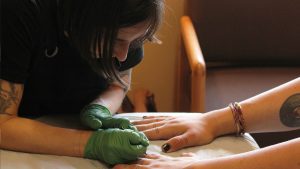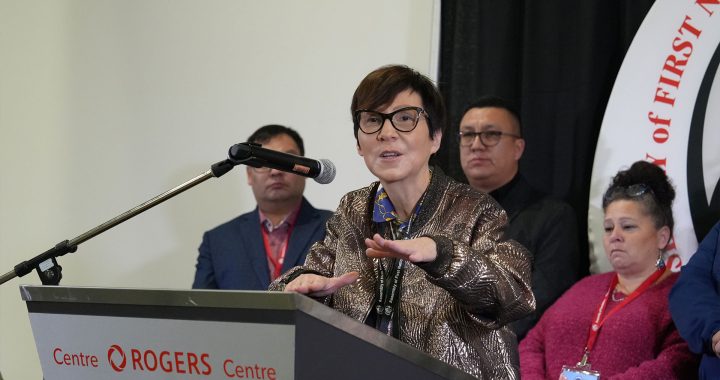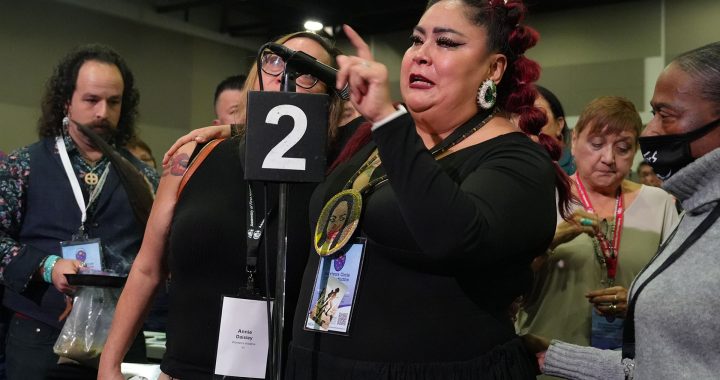In a small room at the Kwanlin Dün First Nation’s health centre in Whitehorse, Anne Spice is laser focused.
With just a single needle, a small cart of supplies and a simple massage bed, the Kwanlin Dün citizen practices an Indigenous custom that was all but eradicated – tattooing.
“They identify us as Indigenous people, and identify us in relation to other people,” Spice told APTN News. “There’s not a lot of people who have living memory of tattooing or have seen tattoos before colonization.”
Spice is a handpoke tattoo artist. It’s a slow, delicate process – at times physically painful – as a needle is continuously dipped into a small carton of ink to manually “poke” the solution into skin.
Spice learned the practice six years ago at an Indigenous land occupation. Her practice is mostly linework with patterns inspired by basketry and other cultural imagery.
Originally from southern Alberta, Spice is an assistant professor of anthropology at the University of Toronto, Mississauga. For the past two summers, she’s returned to her ancestral community to tattoo as part of the Shakaat artist in residence in Whitehorse.
But this summer she’s tattooing for her First Nation. Over the course of the next month, she’ll tattoo more than 24 fellow Kwanlin Dün citizens.
The First Nation’s health and wellness team is paying for her work as part of an initiative to incorporate traditional ways of healing.

One of them is Olvia Gatensby.
Gatensby chose a circle and two lines representing the moon and a river on her fingers, symbols of life change and crossing from one side to the next.
She said it’s fitting imagery as she’s currently in the process of transitioning from male to female.
“The idea of it is connecting with a culture I admittedly (am not connected with). I’m excited about this to make that link,” she said.
Spice said it’s an honour to do the work.
“It can be a really vulnerable place, both materially and emotionally,” she said. “It’s a healing ceremony, but it’s also a painful ceremony. We’re able to kind of work through some of those issues with other people as well. It’s more than just the mark on the skin, but also the process of getting to that mark.”

Revitalizing an ancient practice
Spice said traditional Indigenous tattooing dates back thousands of years and was a thriving practice prior to colonization.
Tattoos were used to mark life transitions, such having children, becoming a warrior and marking the status of chiefdom.
Spice said clan crests were common chest tattoos for Tlingit chiefs. Women would often tattoo their hands and chins to indicate clan membership and coming of age.
She said tattoos were typically done with sharpened bone. Ink was made with charcoal from devil’s club and other medicinal plants.
The process itself would entail poking ink into the skin, rubbing it into cuts or even sewing it into the skin with sinew.
However the practice was frowned upon by missionaries and eventually outlawed along with potlatches by disapproving white settler society. Spice said colonization led to feelings of shame surrounding tattooing.
“I think that there’s still some lingering fear around these kinds of markings,” she said. “That connection has been a source of violence. I can see why it caused some discomfort.”

But the practice hasn’t been totally forgotten.
In recent years, other Indigenous groups such as the Maori in New Zealand are embracing tā moko as are native Hawaiians with kākau.
Popular figures like Quannah Chasinghorse, a Hän Gwich’in and Oglala model who wears yidįįłtoo, traditional face tattoos for Hän Gwich’in women, are also helping push traditional tattoos to the mainstream.
Spice said Indigenous people around the world are rediscovering their culture through tattooing.
“Part of our work is to revive it as a healing practice, help people find pride in that connection – not fear,” she said. “Also, to recognize each other when we see these marks on other people, it’s really to honour that.”
She said tattoos are proof Indigenous culture and customs will continue to be passed down to future generations.
“I really like thinking about how everyone’s going to age and they’re going to be old with these tattoos and then our young people will see old people, like our Elders wearing these marks again. I think it’s so cool.”










